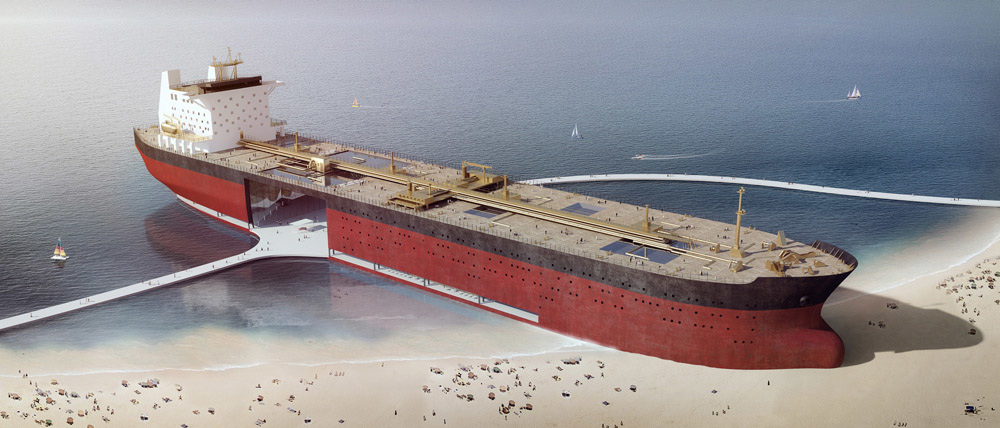Let’s say renewable energy from wind and solar become the new norm, what do we do with the gigantic tankers that ship oil around the world? A group of Dutch artists imagined reusing these behemoths as space usable by the public.
The Black Gold Project is a joint project of artists Chris Collaris Design, Ruben Esser, Sander Bakker, and Patrick van der Gronde, Weburbanist reports.
Based on renderings, the project involves anchoring tankers to the shore as permanent land buildings, designed to accommodate cultural and event spaces, retail, or public parks. In the words of Art Director Ruben Esser, “The Black Gold Project is an answer to the contemporary search for true iconic buildings in the Southern Gulf region.”
“The biggest concern in the newly grounded architectural culture of the post-global cities in the Gulf area can be described as an overdose of pretentious iconic buildings,” designer Chris Collaris contends. “By changing the function of the discarded mega oil tanker in a sustainable and functional way, the anchored mega ship can be kept as a true icon of the Arabic States in Southern Gulf region into the present and next era.”
Weburbanist points out several practical drawbacks to be considered, such as the impact of waves, saltwater, and wind over time. “Still, as a conceptual project, the idea is compelling—if more poetic than realistic,” the article states. “Turn the very vessels responsible for the rise and fall of these oil-producing nations into something new that remains, at the same time, a monument to days gone by."






Related Stories
| Aug 11, 2010
Fleet Library, Rhode Island School of Design
When tasked with transforming an early 1920s Italian Renaissance bank building into a fully functional library for the Rhode Island School of Design, the Building Team for RISD's Fleet Library found itself at odds with the project's two main goals. On the one hand, the team would have to carefully restore and preserve the historic charm and ornate architectural details of the landmark space, d...
| Aug 11, 2010
Gold Award: The Lion House, Bronx Zoo Bronx, N.Y.
Astor Court sits at the heart of the 265-acre Bronx Zoo, and its six Beaux Arts buildings were constructed at the turn of the 20th century to house exotic animals from around the world. When the Lion House was built in 1903, the brick and limestone facility was considered state-of-the-art, but as standards of animal care advanced, the lions were moved into a more natural setting, and the Lion H...
| Aug 11, 2010
The pride of Pasadena
As a shining symbol of civic pride in Los Angeles County, Pasadena City Hall stood as the stately centerpiece of Pasadena's Civic Center since 1927. To the casual observer, the rectangular edifice, designed by San Francisco Classicists John Bakewell, Jr., and Arthur Brown, Jr., appeared to be aging gracefully.
| Aug 11, 2010
Platinum Award: Reviving Oakland's Uptown Showstopper
The story of the Fox Oakland Theater is like that of so many movie palaces of the early 20th century. Built in 1928 based on a Middle Eastern-influenced design by architect Charles Peter Weeks and engineer William Peyton Day, the 3,400-seat cinema flourished until the mid-1960s, when the trend toward smaller multiplex theaters took its toll on the Fox Oakland.







